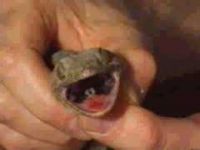Difference between revisions of "Lizard Respiratory System"
| Line 6: | Line 6: | ||
In many lizards gas exchange occurs in the cranial part of the lung, while the caudal portion of the lung is analagous to the avian air sac. | In many lizards gas exchange occurs in the cranial part of the lung, while the caudal portion of the lung is analagous to the avian air sac. | ||
| − | The glottis is generally quite rostral and located at the base of the tongue. It is normally closed except during respiration. This simplifies intubation and tube-feeding. | + | The hard palate is reduced to allow airflow from the inner nasal opening to the '''glotttis'''. The glottis is generally quite rostral and located at the base of the tongue. It is normally closed except during respiration. This simplifies intubation and tube-feeding. |
Revision as of 21:27, 24 February 2010
| This article is still under construction. |
The lungs are simple sacs with internal folds for an increased surface area, unlike the more complex structure of mammalian lungs. The trachea divides into two bronchii which open into the lungs without bronchioles. Respiration, which is voluntary and dependant on blood carbon dioxide pressure and temperature, is aided by expansion and contraction of the ribs as lizards lack a diaphragm.
In many lizards gas exchange occurs in the cranial part of the lung, while the caudal portion of the lung is analagous to the avian air sac.
The hard palate is reduced to allow airflow from the inner nasal opening to the glotttis. The glottis is generally quite rostral and located at the base of the tongue. It is normally closed except during respiration. This simplifies intubation and tube-feeding.
